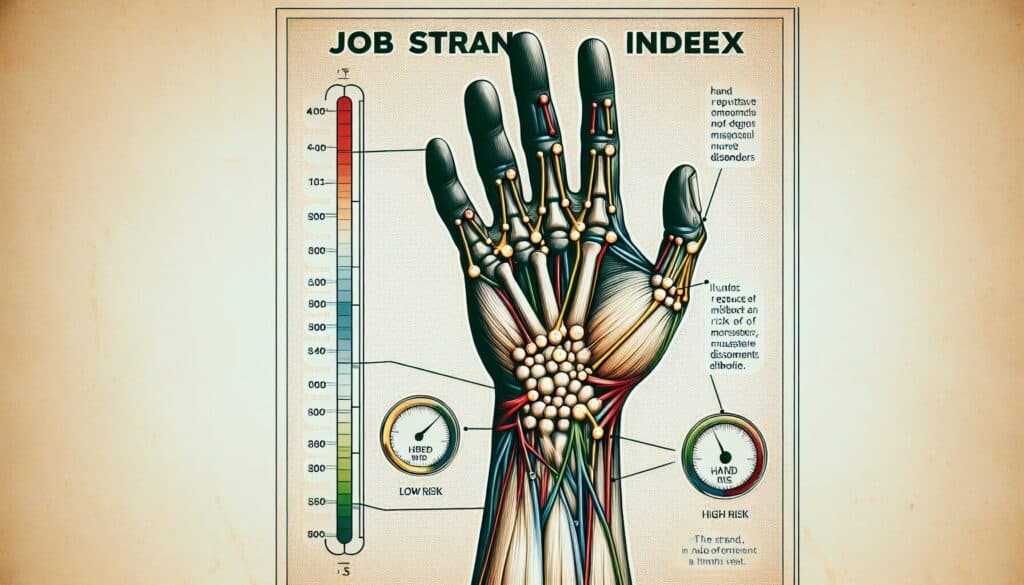A method to assess the risk of musculoskeletal disorders of the hand, wrist, forearm, and elbow, primarily associated with repetitive, forceful exertions.
- Methodologies: Customers & Marketing, Economics
Job Strain Index (JSI)

Job Strain Index (JSI)
- Continuous Improvement, Ergonomics, Health Sciences, Human Factors, Lean Manufacturing, Process Improvement, Quality Management, Risk Management, Safety
Objective:
How it’s used:
- Calculates a score based on intensity of exertion, duration of exertion per cycle, efforts per minute, hand/wrist posture, speed of work, and duration of task per day. A score above a threshold indicates a hazardous job.
Pros
- Relatively simple and quick to apply once data is collected; focuses on key risk factors for distal upper limb disorders; provides a single risk score.
Cons
- Considers a limited number of risk factors; may not be suitable for all types of upper limb tasks; relies on subjective estimation for some factors.
Categories:
- Ergonomics
Best for:
- Evaluating the risk of developing musculoskeletal disorders in the distal upper extremities due to job tasks.
The Job Strain Index (JSI) is particularly beneficial in various sectors that involve manual labor, such as manufacturing, construction, healthcare, and warehousing, where workers are susceptible to musculoskeletal disorders. This methodology is most effectively applied during the ergonomics assessment phase of workplace design or during the evaluation of existing job tasks to identify risks associated with specific work activities. It is typically initiated by occupational health and safety professionals, ergonomists, or human factors specialists, often in collaboration with workers, supervisors, and management to ensure a comprehensive understanding of job demands and work environments. The process includes observational studies and data collection on workers’ tasks, thereby engaging different stakeholders in the evaluation process, including engineers looking to improve workstation designs and occupational therapists assessing the impact of job requirements on individual health. The JSI score serves as a quantifiable measure that can drive interventions, such as redesigning tasks to minimize risk factors, implementing job rotation strategies, or offering training to modify manual handling techniques. Its user-friendly nature allows for quick on-site evaluations, making it a practical tool during safety audits or in the development of workplace initiatives that aim to enhance worker well-being while maintaining productivity standards. By providing a clear numerical risk assessment, JSI aids in prioritizing actions needed for improvement, offering a straightforward approach to risk management in operational settings.
Key steps of this methodology
- Determine the intensity of exertion for each task using a standardized scale.
- Evaluate the duration of exertion per cycle for each identified task.
- Count the number of efforts applied per minute for relevant tasks.
- Assess hand/wrist posture during each task using defined criteria.
- Measure the speed of work for each task as part of the analysis.
- Estimate the duration of the task performed each day.
- Calculate the Job Strain Index score by combining all the assessed parameters.
- Compare the calculated score against established threshold values to determine risk level.
Pro Tips
- Integrate task observations with JSI calculations to capture real-world variations in exertion levels and to inform design adjustments.
- Utilize the JSI data as a baseline for iterative design changes and re-evaluate periodically to track the effectiveness of ergonomic interventions.
- Collaborate with multidisciplinary teams to assess context-specific variables such as environment and workflow, enhancing the accuracy of the JSI application.
To read and compare several methodologies, we recommend the
> Extensive Methodologies Repository <
together with the 400+ other methodologies.
Your comments on this methodology or additional info are welcome on the comment section below ↓ , so as any engineering-related ideas or links.
Historical Context
1986
(if date is unknown or not relevant, e.g. "fluid mechanics", a rounded estimation of its notable emergence is provided)

Related Posts
METS to Calories Calculator
Meta-Analysis
Message Mapping
Mental Model Diagrams
Maximum Acceptable Pushing and Pulling Forces
Material Requirements Planning (MRP)